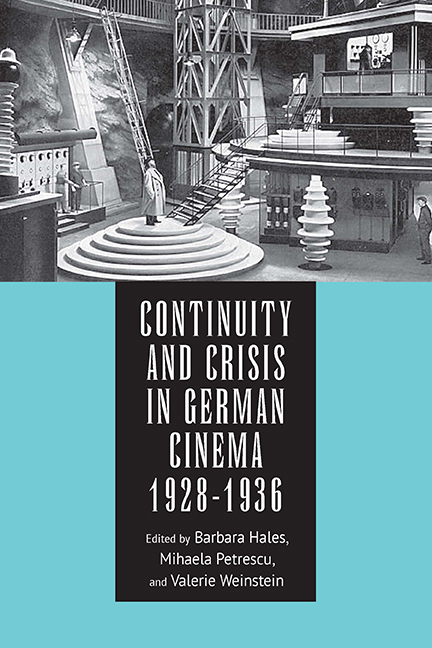Book contents
- Frontmatter
- Contents
- List of Illustrations
- Acknowledgments
- Introduction
- Part I Politics
- Part II The Economy
- Part III Concepts of Race and Ethnicity
- Part IV Genre Cinema
- Part V Making Cinema Stars
- Part VI Film Technologies
- Part VII German-International Film Relations
- Selected Bibliography
- Notes on the Contributors
- Index
1 - “Timid Heresies”: Werner Hochbaum’s Razzia in St. Pauli (1932)
Published online by Cambridge University Press: 08 May 2021
- Frontmatter
- Contents
- List of Illustrations
- Acknowledgments
- Introduction
- Part I Politics
- Part II The Economy
- Part III Concepts of Race and Ethnicity
- Part IV Genre Cinema
- Part V Making Cinema Stars
- Part VI Film Technologies
- Part VII German-International Film Relations
- Selected Bibliography
- Notes on the Contributors
- Index
Summary
A SMALL-TIME CROOK, “Matrosen-Karl,” spontaneously decides to steal a piece of jewelry from an upscale shop in Hamburg by smashing the display window and running off with the loot. He manages to shake off the policemen pursuing him by taking refuge in the narrow lanes of the densely populated slum-like Gängeviertel neighborhood near the harbor. Climbing through an open window, he ends up in the room of “Ballhaus Else,” a prostitute who is home, sick in bed. Unhappy in a stale relationship with “Musiker-Leo,” an anemic, penniless musician, she hides the stranger in her bed when the police search her room. The two start an affair and indulge in dreams of escaping their dreary lives by running away together. That same night, the police investigation closes in on Karl in the shabby tavern where they celebrate their upcoming departure. Karl attacks the chief police detective and is arrested. Her hopes of an escape dashed, Else returns to her musician friend in quiet resignation.
Such is the plot of Razzia in St. Pauli (Police Raid in St. Pauli), the first full-length sound feature film by Werner Hochbaum (1899–1946), which premiered at Berlin's U. T. am Kurfürstendamm theater on May 20, 1932, to generally respectful, sometimes even enthusiastic reviews, especially regarding the excellent cinematography of A. O. Weitzenberg. On the face of it, the plot is unremarkable, in line with countless genre films produced during the Weimar period. Yet what may look like a runof-the-mill blend of social melodrama and crime thriller is informed by an aesthetic sensibility and a social engagement that betray artistic and political ambitions distinctly at odds with commercial Weimar genre cinema. Hochbaum's visually brilliant film is rife with puzzling contradictions and ambiguities that are attributable to many factors: these include the tensions between silent film traditions and the intrinsic logic of the new medium of sound, the clash between documentary aspirations and concessions to genre conventions, the filmmaker's own conflicted politicalaesthetic program within a political Left split by ideological divisions, and perhaps a general sense of lack of orientation prevailing in the last years of the Weimar Republic.
- Type
- Chapter
- Information
- Continuity and Crisis in German Cinema, 1928-1936 , pp. 31 - 50Publisher: Boydell & BrewerPrint publication year: 2016

